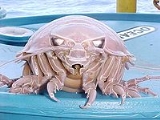
Deep-sea gigantism
Overview
In zoology
, deep-sea gigantism, also known as abyssal gigantism, is the tendency for species of crustaceans, invertebrates and other deep-sea-dwelling animals to display a larger size than their shallow-water counterparts. Examples of this phenomenon include the giant isopod
, the Japanese spider crab
, the king of herrings
(an oarfish
of up to 12 m), the Seven-arm Octopus
, and a number of squid species: the Colossal Squid
(up to 14 m in length), the giant squid
(up to 13 m), the Robust Clubhook Squid
, the Dana Octopus Squid
, Galiteuthis phyllura
, Kondakovia longimana
, and the bigfin squid
s.
It is not known whether this effect comes about as a result of adaptation for scarcer food resources (therefore delaying sexual maturity and resulting in greater size), greater pressure, or for other reasons.
Zoology
Zoology |zoölogy]]), is the branch of biology that relates to the animal kingdom, including the structure, embryology, evolution, classification, habits, and distribution of all animals, both living and extinct...
, deep-sea gigantism, also known as abyssal gigantism, is the tendency for species of crustaceans, invertebrates and other deep-sea-dwelling animals to display a larger size than their shallow-water counterparts. Examples of this phenomenon include the giant isopod
Giant isopod
A giant isopod is any of approximately nine species of large isopods in the genus Bathynomus. They are thought to be abundant in cold, deep waters of the Atlantic...
, the Japanese spider crab
Japanese spider crab
The , Macrocheira kaempferi, is a species of marine crab that lives in the waters around Japan. It has the largest leg span of any arthropod, reaching up to and weighing up to . It is the subject of small-scale fishery.-Description:...
, the king of herrings
King of herrings
The king of herrings or giant oarfish, an oarfish of the family Regalecidae, is the world's longest bony fish. Rarely sighted, it is found in all the world's oceans at depths of between 300 and 1000 meters...
(an oarfish
Oarfish
Oarfish are large, greatly elongated, pelagic Lampriform fishes comprising the small family Regalecidae. Found in all temperate to tropical oceans yet rarely seen, the oarfish family contains four species in two genera...
of up to 12 m), the Seven-arm Octopus
Seven-arm Octopus
The Seven-arm Octopus is the largest known species of octopus based on scientific records, with a total estimated length of 4 m and weight of 75 kg...
, and a number of squid species: the Colossal Squid
Colossal Squid
The colossal squid , sometimes called the Antarctic or giant cranch squid, is believed to be the largest squid species in terms of mass. It is the only known member of the genus Mesonychoteuthis...
(up to 14 m in length), the giant squid
Giant squid
The giant squid is a deep-ocean dwelling squid in the family Architeuthidae, represented by as many as eight species...
(up to 13 m), the Robust Clubhook Squid
Robust Clubhook Squid
The Robust Clubhook Squid , often cited by the older name Moroteuthis robusta, is a species of squid in the family Onychoteuthidae. It is the third largest species of squid after the Colossal Squid and giant squid; and largest of the genus Onykia, reaching a mantle length of . The tentacular clubs...
, the Dana Octopus Squid
Dana Octopus Squid
The Dana Octopus Squid is a species of squid in the family Octopoteuthidae. It is one of the largest known squid species, reaching a mantle length of and total length of...
, Galiteuthis phyllura
Galiteuthis phyllura
Galiteuthis phyllura is a species of glass squid, possibly the largest in the genus.In 1984, the Russian stern-trawler Novoulianovsk brought up the remains of a gigantic specimen of G. phyllura from a depth of 1000–1300 m in the Sea of Okhotsk...
, Kondakovia longimana
Kondakovia longimana
Kondakovia longimana, also known as the Giant Warty Squid or Longarm Octopus Squid, is a large species of hooked squid. It attains a mantle length of at least 85 cm and probably over 1.15 m. The largest complete specimen of this species, measuring 2.3 m in total length, was found in Antarctica in...
, and the bigfin squid
Bigfin squid
The bigfin squids are a group of rarely seen cephalopods with a distinctive morphology. They are placed in the genus Magnapinna and family Magnapinnidae...
s.
It is not known whether this effect comes about as a result of adaptation for scarcer food resources (therefore delaying sexual maturity and resulting in greater size), greater pressure, or for other reasons.
Discussions

